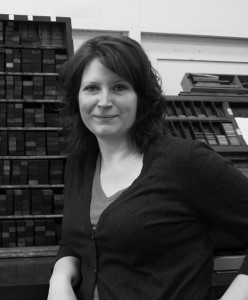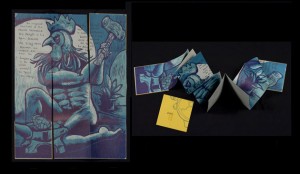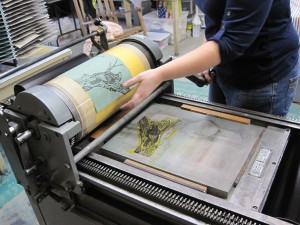Handmade Books: The Story of a Book Artist

Lauren Faulkenberry
What I love about writing is the imagination: the play with language, the weaving of words into story. Being born and raised in the South guaranteed that I’d be a storyteller of some kind, and a compulsion to make art soon led me to making handmade books.
I discovered letterpress printing as an undergraduate and fell in love with the process. It was one thing to write stories, but it was something entirely different to hand-set metal type, print the pages, and make a physical book to house those words.
That was in 2000. For years I traveled in circles–do I want to focus on writing or focus on art? For me, the intersection was artist books. For those who are unfamiliar, letterpress printing uses technology that began with Gutenburg and was finessed in the first half of the 20th century with the likes of Vandercook and Chandler & Price.
It’s manual type-setting: that is, placing single letters one by one to build words on the page; it’s hand-carving images into linoleum and wood blocks. It’s arranging all letters and images backwards so that they print right-reading; it’s printing folios on an ancient printing press, folding them in half, and sewing the printed pages into a book form.
The result is this whole narrative object that a reader can touch and hold–and experience in a sensory way.
It was that physicality that had me first enraptured with letterpress printing. I loved all the processes, from carving wood blocks to rolling the cylinder to print pages. When I learned to make handmade paper, it truly became a process of making from start to finish. It meant that I could print my own words and have total control of what the book looked like.
 There was no editor or art director to revise my vision. And of course, there were these incredible handmade elements that you just don’t see in mass-produced books. The variety of structures are endless: you can make a book that is as much puzzle as it is text. To read a handmade book is to feel the leather that someone pared with hand tools, to see the slight impression of ink pressed into paper, to feel the texture of the page that came from cotton or flax. It is to experience some of what the maker felt as she built this object. It is a sensory feast.
There was no editor or art director to revise my vision. And of course, there were these incredible handmade elements that you just don’t see in mass-produced books. The variety of structures are endless: you can make a book that is as much puzzle as it is text. To read a handmade book is to feel the leather that someone pared with hand tools, to see the slight impression of ink pressed into paper, to feel the texture of the page that came from cotton or flax. It is to experience some of what the maker felt as she built this object. It is a sensory feast.
There’s something magical about making a book this way, to pull sheets of handmade paper, to sew images and words together with a needle and binder’s thread. There is a physicality to the finished object that gives the words more weight, and there’s a commitment to the story. I’ve written this text, sure, but now I’m about to invest weeks upon weeks into giving it a real form that readers can hold in their hands. This is not something you do with a text you like; this is an investment you make in a text you love and admire.
 And how that book feels in a reader’s hands is so important. As a book artist, you make decisions about which papers you want to use–which fibers will make the paper behave the way you want it to: will it be crisp and translucent, revealing layers of story all at one time? Will it be heavy and plush, with a surface you want to touch over and over as you read?
And how that book feels in a reader’s hands is so important. As a book artist, you make decisions about which papers you want to use–which fibers will make the paper behave the way you want it to: will it be crisp and translucent, revealing layers of story all at one time? Will it be heavy and plush, with a surface you want to touch over and over as you read?
Naturally I began by printing my own stories: sometimes single lines of text, excerpts from stories, fragmented memories that are akin to memoir. Sometimes readers call my work “poetry,” but I would never call myself a poet. I was just wrapped up in the love of making art, and finding a way to weave my texts into it. Often the images for my books came first, and the writing was secondary. Sometimes vice-versa. But it seemed that one couldn’t exist without the other.
I actively seek out collaborations with other writers. I love the process of making books and physically printing words on paper, but I sometimes lose interest in my own words. There’s a delight that comes in combining brain power and imagination with someone else, and on occasion I come across a text that I just fall in love with and want to make into a book.
Now that I’m setting up my own studio, I hope to collaborate more often with other writers. Living in a remote part of the mountains, I don’t always have as much interaction with other artists as I would like. Sometimes I struggle with working from home and finding enough inspiration when I’m hunkered down in my remote part of the world. Hence I seek out other writers and artists online, at conferences, and at the occasional craft school or print shop to give me the momentum to keep going during the doldrums.
For me, letterpress printing combines all the things I love about books. In an age where it feels like digital is taking over, something this physical is refreshing. Sometimes I think the renewed interest in letterpress and artist books is a response to the surge in all things digital. Certainly the digital world has its perks for writers, and has given a presence to many voices that might otherwise never have been heard; but for me, letterpress printing does the same thing. It does so in a smaller sphere, but with far more attention to materiality and a kinetic experience with your reader as she holds your work in her hands.
—
Lauren Faulkenberry lives in Whittier, North Carolina. Her handmade books have been shown both nationally and internationally, and are held in Special Collections libraries in the U.S. and abroad. Her children’s alphabet book, “What Do Animals Do on the Weekend?” was published by Novello Festival Press in 2002. Lauren holds an MFA in Creative Writing from Georgia College and an MFA in Book Arts from The University of Alabama. She currently divides her time between freelance writing and teaching workshops in the book arts, and operates under the imprint Firebrand Press.
twitter: @FirebrandPress
facebook page: Firebrand Press
website with porfolio: www.firebrandpress.org
personal blog: therightsideof30.blogspot.com
Category: Contemporary Women Writers, On Writing
























Oh. I want that. I want to hold my book in my hands and know the heart that went into not only the story, but the pages themselves. This has started my yearner. What a lovely thing …
Dear Lauren,
Any chance you studied with Eliot Offner at Smith? That’s where I learned letterpress and pursued for many years after before having to give away all my handpresses (never lucky enough for a Vandercook either!)I still have a full printers case if you ever want some type – would love it to go to a good home! Wish I could study with you some day. Will continue to follow your work and I wish you much happiness and success in keeping this lovely craft alive for the next generation of bibliophiles and letterpress aficionados!
Marie
Hi, Marie– thanks so much for your good wishes! You have quite an amazing story yourself! (I just blog-stalked you because I was curious where you are located :D) I didn’t study with your teacher–I worked with Steve Miller at Alabama and Ken Botnick at Wash U. Can we chat over real email about this type that you need a home for?
Thanks for getting in touch–it would be lovely to collaborate someday, if you find yourself with a piece of writing you’d like to make into a broadside. 😉 Great to connect with you and see your work! Look me up if you ever head down south–I’m starting to teach more workshops now and it would be wonderful to have you join us!
Lauren,
I love book arts and letterpress and handmade paper and binding! I was a book artist for many years before I became a librarian (which I also love)!
It is so heartwarming to see your photos and the Vandercook Press (?). I had a little clamshell press, and Hollander beater for years, but gave them alway (along with my paper press) as I never have the time anymore. Please make sure to send links to your work. Much artistic affection,
Tina
Tina, Thanks so much for the kind words! I got away from letterpress for a few years, and then boomeranged right back. 🙂 Maybe you’ll get back to a press, too! (The librarian/artist combo seems to be a breeding ground for genius!) Good eye–that is a Vandercook I’m using in the photo. Sadly not mine, though. Still hoping to find one someday. To see my work and recent happenings, follow the links to my website/facebook/twitter at the end of this article–I’d love to keep in touch with you!
Love the concept of creating books that allow sensory contact for the reader these books would be popular with people who are vision impaired? It allows a person who is capacity to read a book by touch symbols pictures from what I understand great idea and for children creates a fun and interesting way to reading books.
Hi, Alison- I think you’re right. Artists books open a whole realm of possibility for sensory experiences–I think it would be really interesting to pursue making books that hold enough texture and relief in the pages to tell a narrative though those materials, and not through words at all. You may have given me an idea for my next project…! This raises a great question about storytelling: how can we tell a story without relying solely on written language?
Thanks, Amy! I agree: I love the typing part, but it feels like printing and binding breathes life into them. Plus, teaming up with printers and book artists as collaborators is a great alternative way for writers to get their stories out into the world. I love that we can do this and by-pass the “big” publishers. 🙂
Lauren, what an incredible idea! There is definitely a missing piece with writing on a keyboard. My fingers are sure fast but is that the point? Loved your story, keep going! You’re on to something important. warm regards, Amy Kierce
Thank you so much for this beautifully written piece. It embodies everything I think and feel about writing. I buy notebooks of recycled paper that are sewn together or tied with ribbon or yarn and I copy my poems into them by hand. Like you I am often saddened by the impersonal way modern books come together and feel the artistry has gone out of creative writing. The digital age is a boon to all writers even if it is just to communicate with one another like this. But it does take the heart and love out of the gift of writing which is so very precious. I loved this piece. It truly moved me. Thank you again
Jilly Henderson-Long
Hi, Jilly- thanks so much for the kind words. I’m so glad that you enjoyed this piece. It warms my heart to hear folks like you talk about the “heart and love” that comes with something made by hand–or handwritten. I think there are more people like us out in the world who appreciate that than we realize, and I, for one, need that reminder now and again. 🙂 I’m lucky to have family and friends who treasured things someone made for them by hand (even when I was a kid). I think I do what I do as a direct result of that. I’d love to see your work!
Love to share some with you. Will contact again when I get home this evening and see what we can do. Best wishes. Jilly